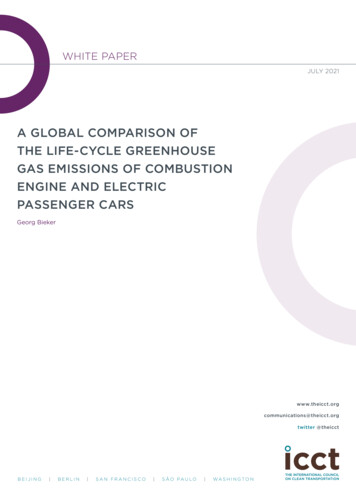
Transcription
WHITE PAPERJULY 2021A GLOBAL COMPARISON OFTHE LIFE-CYCLE GREENHOUSEGAS EMISSIONS OF COMBUSTIONENGINE AND ELECTRICPASSENGER CARSGeorg tter @theicctBEIJING BERLIN SAN FRANCISCO S ÃO PA U LO WA S H I N G T O N
ACKNOWLEDGMENTSThe author thanks all ICCT colleagues who contributed to this report, with specialthanks to Yidan Chu, Zhinan Chen, Sunitha Anup, Nikita Pavlenko, and Dale Hallfor regional data input, and Peter Mock, Stephanie Searle, Rachel Muncrief, JenCallahan, Hui He, Anup Bandivadekar, Nic Lutsey, and Joshua Miller for guidance andreview of the analysis. In addition, the author thanks all external reviewers: PierpaoloCazzola (ITF), Matteo Craglia (ITF), Günther Hörmandinger (Agora Verkehrswende),Jacob Teter (IEA), and four anonymous individuals; their review does not imply anendorsement. Any errors are the author’s own.For additional information:ICCT – International Council on Clean Transportation EuropeNeue Promenade 6, 10178 Berlin 49 (30) 847129-102communications@theicct.org www.theicct.org @TheICCT 2021 International Council on Clean TransportationFunding for this work was generously provided by the European Climate Foundationand the Climate Imperative Foundation.
EXECUTIVE SUMMARYIf the transportation sector is to align with efforts supporting the best chance ofachieving the Paris Agreement’s goal of limiting global warming to below 2 C, thegreenhouse gas (GHG) emissions from global road transport in 2050 need to bedramatically lower than today’s levels. ICCT’s projections show that efforts in linewith limiting warming to 1.5 C mean reducing emissions from the combustion andproduction of fuels and electricity for transport by at least 80% from today’s levelsby 2050, and the largest part of this reduction needs to come from passenger cars.Considering the expected future growth of the transport sector, the change needed ona per-vehicle basis will be even higher.As important as it is to reduce the emissions from fuel and electricity production andconsumption, such reduction should of course not come at the cost of higher vehicleproduction emissions. Taking all together, it is therefore important for policymakers tounderstand which powertrain and fuel technologies are most capable of shrinking thecarbon footprint of cars—and not only the emissions from the tailpipes, but also fromfuel and electricity production and vehicle manufacturing.This study is a life-cycle assessment (LCA) of the GHG emissions of passenger carsin China, Europe, India, and the United States, four markets that are home to themajority of global new passenger car sales and reflect much of the variety in the globalvehicle market. The study considers the most relevant powertrain types—internalcombustion engine vehicles (ICEVs), including hybrid electric vehicles (HEVs); plug-inhybrid electric vehicles (PHEVs); battery electric vehicles (BEVs); and fuel cell electricvehicles (FCEVs)—and a variety of fuel types and power sources including gasoline,diesel, natural gas, biofuels, e-fuels, hydrogen, and electricity. For each region, theanalysis is based on average vehicle characteristics across the most representativemarket segments and considers fuel and electricity consumption in real-world drivingconditions. Additionally, based on stated policies, the study estimates how the lifecycle GHG emissions of cars expected to be registered in 2030 compare with vehiclesregistered today. For both 2021 and 2030 cars, it considers the changing fuel andelectricity mixes during the lifetime of the vehicles.Key results include the following:Only battery electric and hydrogen fuel cell electric vehicles have the potential toachieve the magnitude of life-cycle GHG emissions reductions needed to meet ParisAgreement goals.As shown for average new medium-size cars in Figure ES.1, the assessment findsthat the life-cycle emissions over the lifetime of BEVs registered today in Europe, theUnited States, China, and India are already lower than a comparable gasoline car by66%–69% in Europe, 60%–68% in the United States, 37%–45% in China, and 19%–34%in India. For medium-size cars projected to be registered in 2030, as the electricitymix continues to decarbonize, the life-cycle emissions gap between BEVs and gasolinevehicles increases to 74%–77% in Europe, 62%–76% in the United States, 48%–64% inChina, and 30%–56% in India. As indicated in the figure, a large uncertainty lies in howthe future electricity mix develops in each region; the high ends of the error bars reflectmore emissions when only considering currently existing and announced policies, andthe low ends reflect the implementation of policies the International Energy Agencyprojects would be required for the power sector to align with Paris Agreement targets.iICCT WHITE PAPER GLOBAL COMPARISON OF THE LIFE-CYCLE GREENHOUSE GAS EMISSIONS OF PASSENGER CARS
EuropeUnited StatesIndiaVehicle manufactureFuel/electricity productionMaintenanceFuel consumptionBattery manufactureCurrent policies vs Paris Agreement-compatible electricity mix300Life-cycle GHG emissions (g CO2 eq./km)China250200150100500ICEVBEV2021 carsICEVBEV2030 carsICEVBEV2021 carsICEVBEV2030 carsICEVBEV2021 carsICEVBEV2030 carsICEVBEV2021 carsICEVBEV2030 carsFigure ES.1. Life-cycle GHG emissions of average medium-size gasoline internal combustionengine (ICEVs) and battery electric vehicles (BEVs) registered in Europe, the United States,China, and India in 2021 and projected to be registered in 2030. The error bars indicate thedifference between the development of the electricity mix according to stated policies (thehigher values) and what is required to align with the Paris Agreement.While BEVs registered today already produce significantly lower life-cycle GHGemissions on average, the same is not true for FCEVs fueled by hydrogen. This isbecause the primary source of hydrogen today is through reforming methane fromnatural gas (“grey hydrogen”), and that results in more modest life-cycle emissionsreductions that are about 26%–40% less than for today’s average medium-size gasolinevehicles in the respective regions. Utilizing hydrogen produced from renewableelectricity (“green hydrogen”), instead, would result in 76%–80% lower life-cycle GHGemissions for FCEVs. Renewable energy powered FCEVs show slightly higher lifecycle emissions than BEVs powered by the same renewable electricity, though; this isbecause the electricity-based FCEV pathway is approximately three times as energyintensive as the BEV pathway, and as such, we took account of emissions from theconstruction of additional renewable electricity installations.There is no realistic pathway for deep decarbonization of combustion engine vehicles.HEVs improve the efficiency of internal combustion engine vehicles by recoveringbraking energy and storing it in a battery that can then be used to support propulsionwith an electric motor. In this study, HEVs are found to reduce life-cycle GHG emissionsby only about 20% compared to conventional gasoline cars.PHEVs have a larger battery that can be charged before driving and they can operatein a predominantly electric mode for a certain range. Also in this drive mode, though,the electric motor is usually supported by the combustion engine, and thus it is notnecessarily purely electric driving. In any case, the life-cycle GHG emissions of PHEVsare mostly determined by the electric versus combustion engine drive share in averagereal-world usage. This is found to vary significantly between regions, and the life-cycleGHG emissions of today’s medium-size PHEVs compared to gasoline cars is 42%–46%lower in the United States, 25%–27% lower in Europe, and 6%–12% lower in China,depending on the development of the electricity mix. (PHEVs are hardly registeredin India.) Compared to average BEVs in the United States, Europe, and China, thelife-cycle GHG emissions for PHEVs are 43%–64%, 123%–138%, and 39%–58% higheriiICCT WHITE PAPER GLOBAL COMPARISON OF THE LIFE-CYCLE GREENHOUSE GAS EMISSIONS OF PASSENGER CARS
for cars registered in 2021 and 53%–100%, 171%–197%, and 94%–166% higher for carsexpected to be registered in 2030.This study also analyzed the development of the average blend of biofuels and biogasin fossil diesel, gasoline, and natural gas based on current policies and projectedsupply. Across the four regions and all fuel types, the impact of future changes inthe biofuel blends driven by current policies range from a negligible influence to areduction of the life-cycle GHG emissions of gasoline, diesel, or natural gas vehiclesby a maximum of 9%, even over the lifetime of cars registered in 2030. Due to anumber of factors, including competing demand from other sectors and high cost ofproduction, it is not feasible to supply enough low-carbon biofuels such as residuesand waste-based biodiesel, ethanol, or biomethane to substantially displace fossil fuelsin combustion engine cars. Additionally, the very high production cost of e-fuels meansthey are not likely to contribute substantially to decarbonization of the fuel mix withinthe lifetimes of 2021 or 2030 cars.To align with Paris Agreement targets, the registration of new combustion enginevehicles should be phased out in the 2030–2035 time frame. Given averagevehicle lifetimes of 15–18 years in the markets analyzed and that Paris Agreementreduction targets need to be met by 2050, only those technologies that can achievea deep decarbonization should be produced and registered by about 2030–2035.Based on the assessment presented here, BEVs powered by renewable electricityand FCEVs fueled by green hydrogen are the only two technology pathways thatqualify. Hybridization can be utilized to reduce the fuel consumption of new internalcombustion engine vehicles registered over the next decade, but neither HEVs norPHEVs provide the magnitude of reduction in GHG emissions needed in the long term.Thus, the registration of new cars with these powertrain types needs to be phased outin the 2030–2035 time frame.In the meantime, given the life-cycle GHG emission benefits that BEVs alreadyprovide today, the transition to electric cars need not wait for future power sectorimprovements. Indeed, the benefits of a continuously decarbonizing power sector canonly be captured in full if the transition to electric vehicles proceeds well ahead of that.iiiICCT WHITE PAPER GLOBAL COMPARISON OF THE LIFE-CYCLE GREENHOUSE GAS EMISSIONS OF PASSENGER CARS
TABLE OF CONTENTSExecutive Summary. iList of acronyms. 21Introduction. 32 Methodology. 52.1 Approach and scope. 52.2 Vehicle cycle. 52.3 Fuel cycle. 72.4 Highlight: Battery production emissions.92.5 Highlight: Vehicle lifetime average electricity mix.112.6 Highlight: 20-year global warming potential of methane.123 Europe. 143.1 2021 passenger cars. 143.2 2030 passenger cars.213.3 Summary and conclusions. 254 United States.274.1 2021 passenger cars.274.2 2030 passenger cars. 304.3 Summary and conclusions.325 China.345.1 2021 passenger cars. 345.2 2030 passenger cars. 385.3 Summary and conclusions. 416 India.436.1 2021 passenger cars. 436.2 2030 passenger cars. 476.3 Summary and conclusions. 497 Global summary and implications for policy.517.1 Global trends. 517.2 Policy implications . 56References.58Appendix – Data and assumptions. 64A.1 Vehicle cycle. 64A.2 Fuel cycle. 66A.3 Battery.801ICCT WHITE PAPER GLOBAL COMPARISON OF THE LIFE-CYCLE GREENHOUSE GAS EMISSIONS OF PASSENGER CARS
LIST OF ACRONYMSADACAllgemeiner Deutscher Automobil-ClubBEVBattery electric vehicleCCSCarbon capture and storageCH4MethaneCLTCChina light-duty vehicle test cycleCNGCompressed natural gasCO2Carbon dioxideCO2 eq.Carbon dioxide equivalentEDFEnvironmental Defense FundEPAUnited States Environmental Protection AgencyFAMEFatty acid methyl esterFCEVFuel cell electric vehicleGWPGlobal warming potentialHEVHybrid electric vehicleHVOHydrogenated vegetable oilIEAInternational Energy AgencyJRCJoint Research Center (European Commission)GHGGreenhouse gasICEVInternal combustion engine vehicleILUCIndirect land use changeLCALife-cycle assessmentLNGLiquefied natural gasMIDCModified Indian Driving CycleMSWMunicipal solid wasteN2ONitrous oxideNCALithium nickel cobalt aluminum oxideNEDCNew European Driving CycleNEVNew energy vehiclesNMCLithium nickel manganese cobalt oxidePHEVPlug-in hybrid electric vehicleSDSSustainable Development ScenarioSTEPSStated Policy ScenarioSUVSport utility vehicleTTWTank to wheelWLTPWorldwide Harmonized Light Vehicles Test ProcedureWTTWell to tankWTWWell to wheelZEVZero-emission vehicleZLEVZero- and low-emission vehicle2ICCT WHITE PAPER GLOBAL COMPARISON OF THE LIFE-CYCLE GREENHOUSE GAS EMISSIONS OF PASSENGER CARS
1 INTRODUCTIONOn a global scale, the production and combustion of fuels in the transportation sectorcurrently results in the emission of approximately 12 Gt of CO2 equivalent (CO2 eq.) intothe air per year, and this is about 25% of all anthropogenic greenhouse gas (GHG)emissions. With projected population and economic growth, global transportationdemand is expected to increase substantially. Without further policy action, transportsector GHG emissions from combustion and production of fuels and electricity areexpected to almost double to 21 Gt CO2 eq. annually by 2050. However, supportingefforts in line with the best chances of limiting global warming to 1.5 C means reducingthese emissions by approximately 80% from today’s levels, to a level of about 2.6 GtCO2 eq. per year by 2050 (International Council on Clean Transportation, 2020).Light-duty vehicles, the vast majority of which are passenger cars, are responsiblefor the largest share of transport-related GHG emissions, currently about 5 Gt CO2 eq.(International Council on Clean Transportation, 2020). To reduce the GHG emissionsof light-duty vehicles, many governments follow two complementary approaches: (1)They aim to reduce the fuel consumption of new vehicles by setting fleet average CO2emission or fuel efficiency standards, and by providing incentives for vehicles withelectric powertrains; and (2) They support the decarbonization of the electricity gridand incentivize the production of renewable and low-carbon fuels.In this context, this study evaluates a variety of powertrain and fuel technologypathways to identify which allow for deep reductions in the GHG emissions of theglobal passenger car fleet. It follows a life-cycle assessment (LCA) approach andconsiders the GHG emissions corresponding to fuel and electricity production, aswell as the production, maintenance, and recycling of passenger cars in Europe (theEuropean Union and United Kingdom), the United States, China, and India. Thesefour regions accounted for about 70% of global new car sales in 2019 (EuropeanAutomobile Manufacturers Association, 2020) and are reflective of much of the varietyin the global passenger car market.The life-cycle GHG emissions of gasoline, diesel, and natural gas powered internalcombustion engine vehicles (ICEVs), which include hybrid electric vehicles (HEVs), arecompared to the emissions of plug-in hybrid electric vehicles (PHEVs), battery electricvehicles (BEVs), and fuel cell electric vehicles (FCEVs). For each of the four regions, thestudy considers the life-cycle GHG emissions impact of biofuels under both current andfuture blending rates, future changes in the average electricity grid mixes, and the lifecycle GHG emissions of various pathways of producing hydrogen fuel. To understandthe future potential of the different powertrain types, the GHG emissions over thelifetime of cars registered in 2021 are compared with those of the cars expected to beregistered in 2030.In addition to its regional and temporal scope, this study is distinct from earlier LCAliterature in four key aspects:» This study considers the lifetime average carbon intensity of the fuel and electricitymixes, including biofuels and biogas. Based on stated policies, it accounts forchanges in the carbon intensity during the useful lifetime of the vehicles.» This study considers the fuel and electricity consumption in average real-worldusage instead of solely relying on official test values. This is especially important forassessing the GHG emissions of PHEVs.» This study uses recent data on industrial-scale battery production and considersregional battery supply chains. This results in significantly lower battery productionemissions than in earlier studies.3ICCT WHITE PAPER GLOBAL COMPARISON OF THE LIFE-CYCLE GREENHOUSE GAS EMISSIONS OF PASSENGER CARS
» This study incorporates the near-term global warming potential of methane leakageemissions of natural gas and natural gas-derived hydrogen pathways. Different fromother GHGs, methane contributes several times more to global warming in the first 20years after emission than is reflected by the 100-year global warming potential (GWP).In Section 2, the scope and methodology of this study is described in general terms,and there is additional, particular focus on the assessment of the battery productionemissions, the lifetime average electricity mix, and the 20-year GWP of methaneemissions. Full details of the considered data and assumptions for these and theremainder of the analysis are provided in the Appendix.4ICCT WHITE PAPER GLOBAL COMPARISON OF THE LIFE-CYCLE GREENHOUSE GAS EMISSIONS OF PASSENGER CARS
2 METHODOLOGY2.1 APPROACH AND SCOPEThis LCA generally follows an attributional approach and thereby considers theaverage GHG emissions that can be attributed to the vehicle and fuel pathways overtheir lifetime. Some values, like the indirect land use change emissions of biofuelproduction, are captured by a consequential approach. As such, those values reflectthe changes the production causes in the broader economy.The overarching goal of this work is to identify the powertrain technologies thatallow a deep reduction of the 100-year GWP (in CO2 eq.) of passenger cars withinthe existing or planned policy frameworks, and 100-year GWP is dominant in theliterature. For methane emissions, which mostly occur during natural gas productionand transport, the 20-year GWP is several times higher than the 100-year GWP,however, and this is different from the other GHGs considered. To account for that,the study also estimates the 20-year GWP of methane emissions for natural gas andnatural gas-derived hydrogen.Four regions are assessed—Europe (the European Union and United Kingdom),the United States, China, and India—and the study considers the life-cycle GHGemissions of gasoline, diesel, and compressed natural gas (CNG) powered ICEVs,PHEVs, BEVs, and FCEVs, whichever powertrains are used in the given region. Thepowertrain types are compared using sales-weighted average characteristics acrossthe most representative market segments. The fuel and electricity consumption valuescorrespond to real-world driving conditions, and except for hydrogen, the studyconsiders average electricity and fuel mixes. On a temporal scale, the study assessesthe life-cycle GHG emissions of cars registered in 2021 and compares them withestimations of cars expected to be registered in 2030. Changes in the average carbonintensity of the fuel and electricity mix during the lifetime of the 2021 and 2030 carsare based on stated policies.The GHG emissions of vehicle production, maintenance, and recycling (i.e., vehiclecycle) and fuel and electricity production and consumption (i.e., fuel cycle) arecombined into a single value based on the functional unit of g CO2 eq./km traveled. Aslisted in Tables 2.1 and 2.2 and described in Sections 2.2 and 2.3, the analysis includesall direct and indirect GHG emissions with a significant influence on the total life-cycleGHG emissions of the different powertrains. Meanwhile, emissions corresponding to theconstruction and maintaining of the infrastructure for vehicle production and recycling,fuel transport and distribution, and vehicle charging, and emissions corresponding toroad infrastructure, are not considered, as these are similar for the different powertraintypes or have only a small influence on total life-cycle GHG emissions.2.2 VEHICLE CYCLEThe vehicle cycle considers the GHG emissions of vehicle production, maintenance, andrecycling (“cradle to grave”). Vehicle production and recycling (where applicable) areconsidered with respect to three categories of components: the battery of BEVs andPHEVs, the hydrogen system of FCEVs, and the rest of the vehicle, which is denotedas glider and powertrain. This separate estimation of the GHG emissions of the batteryand the hydrogen system is important because the GHG emissions of the rest of thevehicle are relatively powertrain-type agnostic. Table 2.1 summarizes the boundaries ofthe GHG emissions considered in the vehicle cycle, including those corresponding tothe maintenance during the use phase of the vehicles. With the region-specific lifetimemileage, the GHG emissions corresponding to the glider and powertrain, the battery,and the hydrogen system are translated into the functional unit of g CO2 eq./km traveled.While the battery production GHG emissions are further discussed in Section 2.4,5ICCT WHITE PAPER GLOBAL COMPARISON OF THE LIFE-CYCLE GREENHOUSE GAS EMISSIONS OF PASSENGER CARS
details regarding the glider and powertrain, hydrogen system, and lifetime mileage areprovided in Section A.1 of the Appendix.Table 2.1. Scope of GHG emissions considered in the vehicle cycle.Glider andpowertrainBattery Production of the vehicle, including raw material extraction andprocessing, component manufacture, and assembly Recycling of vehicle components, time-sensitive hybrid of avoidedburden and cut-off approach Production of the battery packs, including extracting and processing ofraw materials, cell production, and pack assembly Not included: second-life use and recyclingHydrogen system Production of the hydrogen tank and fuel cell, including raw materialextraction and processing, and component manufacture Not included: component recycling/disposalMaintenance In-service replacement of consumables, including tires, exhaust/aftertreatment, coolant, oil, urea, and othersGlider and powertrainThe GHG emissions of the production and recycling of the vehicles’ glider andpowertrain are based on powertrain type-specific factors (in t CO2 eq./t vehicle) and thesegment-specific average weight of cars registered in the analyzed regions in 2019.With a continuous decarbonization of the economy, these GHG emission factors areassumed to be lower in 2030. Vehicle weight is assumed to remain constant.BatteryThe production of the battery in BEVs and PHEVs is calculated with regionally andtemporally adjusted carbon intensity factors (in kg CO2 eq./kWh) and battery capacities(in kWh). For cars registered in 2021, the GHG emission factors of the battery productionare based on the most common battery chemistry, NMC622-graphite batteries, andthe regional mix of batteries produced in or imported from Europe, the United States,China, South Korea, and Japan in 2019. For cars expected to be registered in 2030, thesefactors correspond to NMC811-graphite batteries that are produced domestically inthe regions examined in this study. The battery capacities considered for BEVs in 2021are the segment-specific market averages in 2019, and for PHEVs, they correspond torepresentative models. With the expected decrease in battery costs, the capacities ofBEV and PHEV batteries are assumed to be higher in 2030.Battery recycling is likely to significantly reduce the GHG emissions impact of batteries.Due to uncertainty regarding future recycling processes, however, the correspondingGHG emission credits are not included in this assessment. Similarly, the reduced GHGemissions impact of use of vehicle batteries in second-life applications is discussed,but due to the uncertainty of the battery lifetime, it is not considered. In any case, thebatteries are assumed to last longer than the vehicles’ lifetime (Harlow et al., 2019), sothey do not need to be replaced.Hydrogen systemThe GHG emissions corresponding to the hydrogen tank and fuel cell in FCEVs varywith the capacity of the hydrogen tank and mostly come from the energy-intensiveproduction of carbon fiber reinforced plastic for the hydrogen tank. Same as what isassumed for the batteries of BEVs and PHEVs, hydrogen systems are assumed to beproducible with 20% lower GHG emissions in 2030. As materials from carbon fiberreinforced plastic are currently incinerated or disposed as landfill, the recycling ofhydrogen tanks is not considered in this analysis. With recycling processes currentlybeing developed (Karuppannan Gopalraj & Kärki, 2020), though, the GHG emissions ofthe hydrogen system might be reduced in the future.6ICCT WHITE PAPER GLOBAL COMPARISON OF THE LIFE-CYCLE GREENHOUSE GAS EMISSIONS OF PASSENGER CARS
MaintenanceDuring the use phase of the vehicles, the replacement of vehicle components like tiresand parts of the exhaust/aftertreatment system, and of consumables like coolant,oil, and urea, correspond to GHG emissions. Since they require only some of thesematerials, BEVs and FCEVs correspond to slightly lower maintenance GHG emissionsthan ICEVs and PHEVs.Lifetime mileageThe lifetime mileages used in this analysis were based on the average lifetime ofvehicles registered in the investigated regions in 2021 and expected to be registered in2030, in combination with annual mileage per vehicle age curves and average annualmileage data. The values are adjusted to the respective regions and vehicle segmentsbut are considered to be the same for all powertrain types. The vehicles are consideredto be used in the respective regions for their full useful life, with no consideration oftheir potential export as second-hand cars to other regions.2.3 FUEL CYCLEThe GHG emissions from the fuel and electricity consumed during driving areconsidered in the fuel cycle. These include the GHG emissions from the production ofthe fuel and electricity (“well to tank,” or WTT) and the fuel consumption in the vehicle(“tank to
achieve the magnitude of life-cycle GHG emissions reductions needed to meet Paris Agreement goals. As shown for average new medium-size cars in Figure ES.1, the assessment finds that the life-cycle emissions over the lifetime of BEVs registered today in Europe, the United States, China, and India are already lower than a comparable gasoline car by











